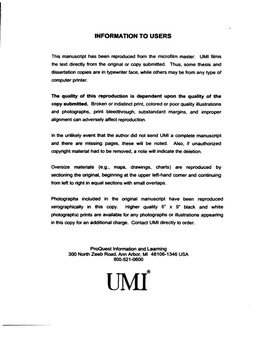| dc.contributor.advisor | Strevett, Keith A., | en_US |
| dc.contributor.author | Chen, Gang. | en_US |
| dc.date.accessioned | 2013-08-16T12:18:29Z | |
| dc.date.available | 2013-08-16T12:18:29Z | |
| dc.date.issued | 2002 | en_US |
| dc.identifier.uri | https://hdl.handle.net/11244/423 | |
| dc.description.abstract | As both deposition and retardation occur during bacterial transport, the deposition coefficient and retardation factor have been widely used individually in describing the transport of bacteria through porous media. Rijnaarts et al. has demonstrated that a combination of both parameters is required to accurately describe microbial transport in porous media. This study is to relate deposition and retardation to surface interactions between microbes and porous media, which are determined by the surface thermodynamics of the microbes and the media as well as the radius of the microbes. | en_US |
| dc.description.abstract | A quantitative understanding of microbial migration in geological formations is critical to predict the dissemination of microbes in the environment and to evaluate the efficacy of microbially mediated in situ pollutant degradation. The key event that retards the movement of microorganisms in the saturated zone is their interactions with matrix surfaces, which may result in adhesion. These interactions are determined by surface thermodynamic properties of the microorganisms and the matrix. The extended DLVO theory, which includes a short-range hydrophobic force, provides a theoretical framework for describing and predicting these interactions. Because of the variable nature of bacterial cell surfaces with the microorganisms, physiological state and macro-nutrient ratio, the surface thermodynamics are highly dependent on the cell's growth state and such dependence requires quantification. Finally, hydrodynamic forces may be significant in determining the surface-surface interactions and should be included in a complete description of microorganism migration. These interfacial interactions can be related to microbial transport in porous media. | en_US |
| dc.description.abstract | Two types of models are often used to describe the transport of micro-size particles (colloids or biocolloids) in porous media: the Deep-Bed Filtration Model and the Convection-Dispersion Model. The Deep-Bed Filtration Model describes a process in which colloidal particles present in the flowing suspension are deposited within the porous media. The deposition of the colloids is considered to be irreversible and no consideration is given to hydrodynamic forces that may remove the particles from the surface and suspend them again in the flowing fluid. The Convection-Dispersion Model describes the movement and spreading of the colloids during transport based on the assumption that given long enough time, all the particles transported can be recovered. Each model has its own parameter for describing the transport. The Deep-Bed Filtration Model utilizes the deposition coefficient, a parameter that describes irreversible adsorption (i.e., deposition) of the colloids on the media; while the Convection-Dispersion Model uses the retardation factor, a parameter that describes reversible adsorption (i.e., retardation) of the colloids when passing through the media. | en_US |
| dc.format.extent | xiv, 193 leaves : | en_US |
| dc.subject | Engineering, Civil. | en_US |
| dc.subject | Colloids. | en_US |
| dc.subject | Microbial growth. | en_US |
| dc.subject | Engineering, Environmental. | en_US |
| dc.subject | Biology, Microbiology. | en_US |
| dc.subject | Bacterial cell surfaces. | en_US |
| dc.title | Impact of physiological state and macro-nutrient ratio on microbial surface thermodynamics and transport. | en_US |
| dc.type | Thesis | en_US |
| dc.thesis.degree | Ph.D. | en_US |
| dc.thesis.degreeDiscipline | School of Civil Engineering and Environmental Science | en_US |
| dc.note | Major Professor: Keith A. Strevett. | en_US |
| dc.note | Source: Dissertation Abstracts International, Volume: 63-01, Section: B, page: 0400. | en_US |
| ou.identifier | (UMI)AAI3040839 | en_US |
| ou.group | College of Engineering::School of Civil Engineering and Environmental Science | |
